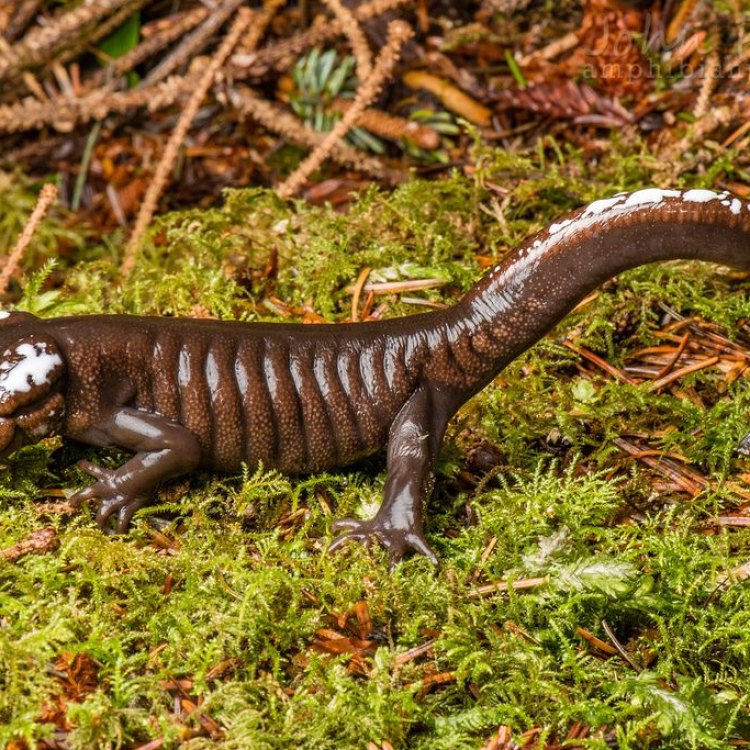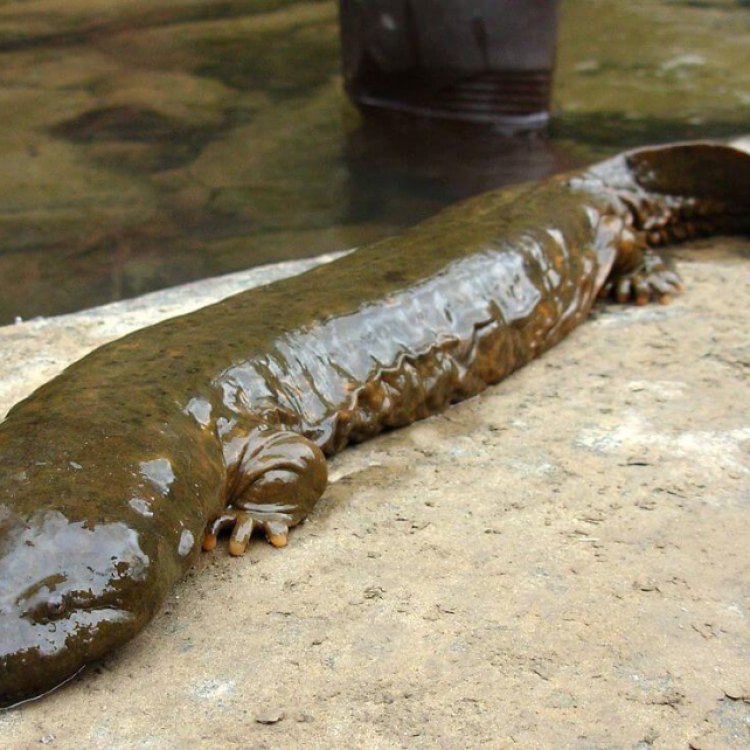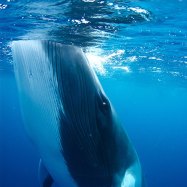
Giant Salamander
1 to 1.8 meters (3.3 to 5.9 feet)
The Giant Salamander, found in Asia, is one of the largest amphibians in the world, measuring 1 to 1.8 meters in length. With a long and cylindrical body shape, these creatures are unique and fascinating to observe. As a member of the Cryptobranchidae family, their name means hidden gills, as they have internal gills that are only visible during their larval stage.
Animal Details Summary:
Common Name: Giant Salamander
Kingdom: Animalia
Habitat: Rivers, streams, and lakes
The Giant Salamander: A Magnificent Creature of Eastern Asia
The natural world is full of incredible creatures, each with their unique characteristics and adaptations. And among these magnificent creatures is the Giant Salamander, also known as the Cryptobranchidae. These ancient amphibians have been around for millions of years and have earned a place of awe and wonder in the hearts of many.The Giant Salamander belongs to the Animalia kingdom, Chordata phylum, and Amphibia class Giant Salamander. They are part of the Caudata order and Cryptobranchidae family. The name "giant" is no exaggeration, as these amphibians can grow up to an astonishing 1.8 meters or 5.9 feet in length, making them one of the largest amphibians in the world.
They are predominantly found in Eastern Asia, with their habitat consisting of rivers, streams, and lakes. Specifically, they are native to countries like China, Japan, and Korea, making them a prominent part of Asian culture and mythology.
The Giant Salamander's scientific name, Cryptobranchidae, is a combination of two Greek words - “kryptos,” meaning hidden or secretive, and “branchos,” meaning gill. This name aptly describes their unique adaptation, which allows them to stay hidden in the water while still breathing through their gills.
One of the most striking features of the Giant Salamander is its dark brown or grey coloration, which can sometimes have mottled patterns Gazelle. This color provides excellent camouflage in their natural habitat, making it easier for them to hunt and avoid predators.
Their long and cylindrical body shape also aids in their ability to move swiftly through the water. They have four short, stocky legs with webbed feet that allow them to swim effortlessly, making them well-suited for their aquatic lifestyle.
But what truly sets the Giant Salamander apart is its impressive size. As mentioned earlier, they can grow up to 1.8 meters long and can weigh up to 65 kilograms or 143 pounds. This size makes them a formidable predator in their habitat, capable of preying on a variety of animals, including fish, frogs, and even small mammals.
Their feeding method is carnivorous, and they use their large mouths and sharp teeth to catch their prey. Unlike other amphibians, they have a keen sense of smell, which helps them locate their prey in the murky waters where they reside.
Due to their size and hunting abilities, the Giant Salamander is often considered the apex predator in their habitat, meaning they have no natural predators. However, humans have become one of their biggest threats in recent years.
The Giant Salamander is an important part of Eastern Asian culture and mythology, with many legends surrounding this magnificent creature. In Japan, they are called “hanzaki,” and it is believed that they can predict natural disasters. In China, they are known as “to wo” and are believed to possess medicinal properties.
Unfortunately, the Giant Salamander's population has been declining due to various factors, such as pollution, habitat destruction, and over-harvesting for consumption in traditional Chinese medicine. The decline in their population is further exacerbated by their relatively slow reproductive rate, with females only laying eggs every other year.
In recent years, conservation efforts have been implemented to protect these ancient amphibians. In China, they have been listed as a National Protected Species, making it illegal to hunt or harm them. Several breeding programs have been established, and scientists are working to study and understand their behavior in hopes of aiding their survival.
The Giant Salamander is a vital part of the ecosystem in which it resides, and its decline would have a significant impact on the balance of the ecosystem. For instance, the Giant Salamander plays a crucial role in maintaining the population of other species, such as fish and insects, by controlling their numbers.
In addition, the Giant Salamander's unique physiology has been the subject of scientific research, leading to potential solutions for human health problems. One such example is their ability to regenerate limbs and organs, which has sparked interest in the field of regenerative medicine.
Despite their incredible size and abilities, there is still much to learn about the Giant Salamander. With ongoing conservation efforts and scientific studies, we hope to unlock more secrets about these fascinating creatures and ensure their survival for generations to come.
In conclusion, the Giant Salamander is a magnificent creature that represents the harmonious relationship between humans and nature. Its impressive size, unique adaptations, and cultural significance make it an essential part of Eastern Asia's ecosystem and culture. But with their population on the decline, it is our responsibility to protect and preserve these ancient amphibians for future generations. So, let us all do our part in ensuring that this magnificent creature continues to thrive in its natural habitat.

Giant Salamander
Animal Details Giant Salamander - Scientific Name: Cryptobranchidae
- Category: Animals G
- Scientific Name: Cryptobranchidae
- Common Name: Giant Salamander
- Kingdom: Animalia
- Phylum: Chordata
- Class: Amphibia
- Order: Caudata
- Family: Cryptobranchidae
- Habitat: Rivers, streams, and lakes
- Feeding Method: Carnivorous
- Geographical Distribution: Eastern Asia (China, Japan, and Korea)
- Country of Origin: China
- Location: Asia
- Animal Coloration: Dark brown or grey, sometimes with mottled patterns
- Body Shape: Long and cylindrical
- Length: 1 to 1.8 meters (3.3 to 5.9 feet)

Giant Salamander
- Adult Size: Large (one of the largest amphibians in the world)
- Average Lifespan: Up to 80 years
- Reproduction: Aquatic eggs
- Reproductive Behavior: External fertilization
- Sound or Call: Loud vocalizations
- Migration Pattern: No regular migration patterns
- Social Groups: Solitary
- Behavior: Nocturnal
- Threats: Habitat loss, pollution, over-harvesting
- Conservation Status: Endangered
- Impact on Ecosystem: Top predator, important for maintaining healthy aquatic ecosystems
- Human Use: Traditional medicine, food
- Distinctive Features: Large size, wrinkled skin, small eyes
- Interesting Facts: Giant salamanders have been known to live for over 50 years in captivity.
- Predator: Few natural predators

Cryptobranchidae
The Fascinating Giant Salamander: A Unique Amphibian
The world is full of fascinating creatures, each with their own distinctive features and behaviors. Among them, the giant salamander stands out as one of the most intriguing and unique amphibians on the planet. With its large size, long lifespan, and important role in the ecosystem, the giant salamander is a creature worth learning more about.So, what exactly is a giant salamander?
As the name suggests, the giant salamander (scientifically known as Andrias spp PeaceOfAnimals.Com.) is a large amphibian. In fact, it is considered to be one of the largest amphibians in the world, with some species reaching lengths of over 5 feet and weighing up to 110 pounds. These incredible creatures can be found in various parts of Asia, including China, Japan, and Korea.
One of the most fascinating aspects of the giant salamander is its average lifespan. While most amphibians have a relatively short lifespan, the giant salamander can live for up to 80 years. This makes them one of the longest-living amphibians in the world, with some individuals even surpassing 50 years of age in captivity.
But what sets the giant salamander apart from other amphibians is not only its size and lifespan, but also its reproductive behavior and distinctive features.
Reproduction and Behavioral Patterns
Like most amphibians, giant salamanders reproduce by laying eggs. However, what makes them unique is that their eggs are aquatic, meaning they are laid in the water Grey Reef Shark. This process is known as external fertilization, where the male fertilizes the eggs after they have been laid by the female.
In terms of their behavioral patterns, giant salamanders are known to be solitary creatures. They do not form social groups and are typically active at night, making them nocturnal animals. They are also known for their loud vocalizations, which they use to communicate with other salamanders.
Additionally, giant salamanders do not have any regular migration patterns. They generally remain in the same area for most of their lives, only moving when necessary due to changes in their environment or for breeding purposes.
Distinctive Features and Predators
One look at a giant salamander and you can immediately tell that it is no ordinary amphibian. They have a very unique appearance, with large sizes, wrinkled skin, and small eyes. Their skin is a defining characteristic, as it is not only wrinkled but also has a slimy texture that helps them to stay hydrated.
Interestingly, the giant salamander has very few natural predators. Their large size and slimy skin make them unappetizing to most predators. However, young salamanders may fall prey to larger fish, birds, and other animals.
The Threats and Conservation Status of Giant Salamanders
Unfortunately, despite their impressive features and important role in the ecosystem, giant salamanders are facing serious threats to their survival. Habitat loss, pollution, and over-harvesting are the main factors contributing to the decline of their population. Due to their slow reproductive rate and long lifespan, it is difficult for them to recover from these threats.
As a result, the conservation status of giant salamanders is now listed as endangered by the International Union for Conservation of Nature (IUCN). This means that they are at a very high risk of extinction in the wild without immediate and effective conservation efforts.
Impact on the Ecosystem
Giant salamanders play an essential role in maintaining healthy aquatic ecosystems. As top predators, they keep populations of other animals in check and help to maintain a balance in the ecosystem. They also serve as a food source for other animals, and their presence indicates a healthy and functioning ecosystem.
Human Use and Interesting Facts
While giant salamanders may have few natural predators, they are unfortunately under threat from humans. These creatures have been used in traditional medicine for centuries, as it is believed that their eggs and body parts have medicinal properties. In some cultures, giant salamanders are also considered a delicacy, with their meat being enjoyed as food.
As a result of human use and exploitation, giant salamanders have declined significantly in the wild. However, efforts are being made to reduce their use in traditional medicine, and laws have been put in place to regulate their harvesting for food.
On a more positive note, there are also some interesting facts about giant salamanders that may surprise you. As mentioned earlier, these creatures can live for up to 80 years, with some individuals living even longer in captivity. They are also known for their unique ability to regenerate lost body parts, such as limbs or even parts of their brain. This makes them one of the most resilient amphibians in the world.
In Conclusion
The giant salamander is truly a remarkable creature. From its large size and long lifespan to its unique reproductive behavior and distinctive features, it is easy to see why it has captured the curiosity of scientists and animal lovers alike. With efforts being made to protect and conserve these amazing creatures, we can only hope that future generations will get to witness their magnificence in the wild.

The Giant Salamander: A Magnificent Creature of Eastern Asia
Disclaimer: The content provided is for informational purposes only. We cannot guarantee the accuracy of the information on this page 100%. All information provided here may change without prior notice.












